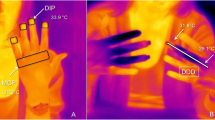Abstract
An objective test for the diagnosis of Raynaud’s phenomenon is useful for three reasons: 1. the phenomenon may not be evident at the time of the clinical examination, 2. proof of diagnosis is required by insurance companies when an occupational origin is suspected, and 3. to assess drug induced improvement. Most cold tests in the medical literature are either complex and expensive or unreliable for routine clinical use. We studied cold induced post-ischemic reactive hyperemia in 14 patients with Raynaud’s disease and in 15 healthy controls. The hand was immersed in a stirred water bath at 13°C, and ischemia was induced by placing an inflatable tourniquet around a finger for five minutes. Afterwards the tourniquet was deflated while the hand remained in the cold water bath. The temperature of the finger with the deflated tourniquet was compared with that of an adjacent finger serving as control. Hyperemia was the increase in differential temperature between these two fingers after tourniquet release minus the difference in temperature existing before deflating the tourniquet. With a normal lower limit of 0.7°C for hyperemia, 13 of the 14 patients with Raynaud’s phenomenon were abnormal (93% sensitivity), and 14 of the 15 controls were normal (93% specificity). All these 14 controls were also normal at a second examination done to assess test reproducibility. A false—positive healthy control was still positive at the second examination. This new, simple and inexpensive cold test can reliably diagnose Raynaud’s phenomenon. Further studies are necessary to establish its reliability in monitoring the effectiveness of treatment in prospective trials.
Similar content being viewed by others
References
MARICQ HR, WEINRICH MC, KEIL JE, LEROY EC. Prevalence of Raynaud’s phenomenon in the general population.J Chronic Dis 1986;6: 423–427.
PROTEAU J, DOMONT A. La législation française concernant la maladie des vibrations et l’intoxication au chlorure de vinyle.J Mal Vasc 1985;10: 264–274.
NIELSON SL, LASSEN NA. Measurement of digital blood pressure after local cooling.J Appl Physiol 1977;43: 907–910.
KRAHENBUHL B, NIELSON SL, LASSEN NA. Closure of digital arteries in high vascular tone states as demonstrated by measurement of systolic blood pressure in the fingers.Scand J Clin Lab Invest 1977;37: 71–76.
NIELSEN SL. Raynaud phenomena and finger systolic pressure during cooling.Scand J Clin Lab Invest 1978;38: 765–770.
COFFMAN JD, COHEN AS. Total and capillary fingertip blood flow in Raynaud’s phenomenon.New Engl J Med 1971;285: 259–263.
DOWNEY JA, FREWIN DB. The effect of cold on blood flow in the hand of patients with Raynaud’s phenomenon.Clin Sci 1973;44: 279–289.
ROALD OK, SEEM E. Treatment of Raynaud’s phenomenon with Ketanserin in patients with connective tissue disorders.Br Med J 1984;289: 577–579.
SMITH CD, McKENDRY RJR. Controlled trial of Nifedipine in the treatment of Raynaud’s phenomenon.Lancet 1982;II: 1299–1301.
VAYSSAIRAT M., PRIOLLET P. Atlas pratique de capillaroscopie. 1983. Paris, La revue de médecine edt. 108–109.
KRAHENBUHL B. Une méthode utile pour le diagnostic du phénomène de Raynaud: la suppression par le froid de l’hyperhémie réactionnelle post-ischémique digitale.Schweiz Med Wschr 1977;49: 1831–1833.
JUUL C, NIELSEN SL. Locally induced digital vasospasm detected by delayed rewarming in Raynaud’s phenomenon of occupational origin.Br J Ind Med 1981;38: 87–90.
VAYSSAIRAT M, MATHIEU JF, HOUSSET E. Hémodynamique de l’artère digitale au chaud et au froid des sujets sains. dans la sclérodermie généralisée et dans la maladie de Raynaud.J Mal Vasc 1984;9: 7–10.
RODEHEFFER RJ, ROMMER JA, WIGLEY F, SMITH CR. Controlled double-blind trial of Nifedipine in the treatment of Raynaud’s phenomenon.N Engl J Med 1983;308: 880–883.
Author information
Authors and Affiliations
About this article
Cite this article
Vayssairat, M., Evenou, P., Baudot, N. et al. A new cold test for the diagnosis of Raynaud’s phenomenon. Annals of Vascular Surgery 1, 474–478 (1987). https://doi.org/10.1007/BF02732674
Issue Date:
DOI: https://doi.org/10.1007/BF02732674




